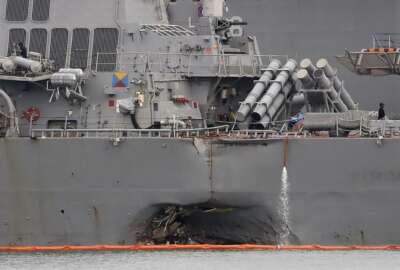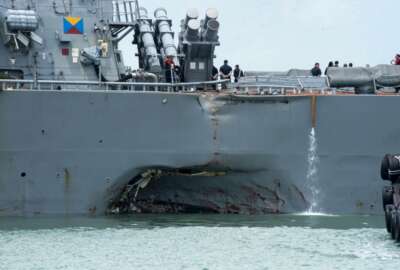
Navy ship crashes: Worse than you thought!
In retrospect, it's a wonder the Navy hasn't had more accidents.
With our studios next door to the D.C. Metropolitan Police District 2 station, I watch daily as motorcycle cops come and go on Idaho Ave. NW. They don’t let just anyone join a police motorcycle unit, even if you slammed dirt bikes on your uncle’s farm since the age of six. To the contrary, it requires intense training and periodic re-training, all followed by tricky road tests supervised by tough old dudes with pot bellies. The best two-wheeled officers can make 1,000-pound motorcycles do what looks impossible to us regular riders.
So it is with naval ships. No news here. Skippering a U.S. Navy vessel is a serious and extremely demanding deal. If a motorcycle cop scrapes his floorboard on a sharp turn, no big deal. If a Navy captain scrapes bottom with his ship, it’s off to a desk job.
If nothing else, the armed services are training-training-training organizations. I watched a video the other day showing preparation of a B-52 for a mission. This requires what looked like a dozen people on the ground all doing precision movements with complicated equipment. One goof and you could bend a crucial mount or punch a hole in the skin.
Yet today two admirals will appear before the House Armed Services Committee to explain why neither of two 7th Fleet ships involved in fatal collisions were certified in the missions they were conducting. Also testifying will be John Pendleton of the Government Accountability Office. His group has published many audits looking at everything from ship construction snafus to crews and operations.
A GAO report from May points out that the Navy has been reducing ship staffing since 2001. Somewhere along the line the work week went from 67 hours to 70. That cut personnel costs but started driving up maintenance costs. Under “optimal manning”, automation technology was supposed to make up for smaller crews. In fact, crew sizes crept up because the productivity yields from technology never materialized.
So why lengthen the workweek?
It turns out, starting in 2010 the Navy reviewed “optimal manning” and restored some of the ship-board positions by 2015. One reason is injury rates also rose in the so-called optimal period. But it kept the 70-hour workweek. A subsequent Navy review, the GAO reports found this eye-popper:
“Sailors were on duty 108 hours a week, exceeding their weekly on-duty allocation of 81 hours. This on-duty time included 90 hours of productive work—20 hours per week more than the 70 hours that is allotted in the standard workweek. This, in turn, reduced the time available for rest and resulted in sailors spending less time sleeping than was allotted, a situation that the study noted could encourage a poor safety culture.” A 2014 Navy study found a persistent problem in obtaining sufficient billets to properly man its ships. In turns out, during much of that on-board overtime, the more senior or experienced crew members are training the less-experienced, instead of sleeping. Which means ships leave port with pre-existing training gaps.
See where this is going?
In recent years, deployments have grown longer and more frequent, as noted by analyst and former Navy officer Bryan Clark in my recent interview with him.
It all adds up to an overworked and understaffed Navy, now sending ships in to crowded, contested waters without having met the Navy’s own certification standards. If the police won’t send a single officer out on a $25,000 motorcycle without the proper training and certification, why should the Navy send out a billion dollar ship with 2,600 sailors aboard who aren’t all trained sufficiently? The question has neither a single answer, nor a single goat on which to load the blame. It’s proof, though, that the concept of doing more with less is a fool’s errand.
Copyright © 2025 Federal News Network. All rights reserved. This website is not intended for users located within the European Economic Area.
Tom Temin is host of the Federal Drive and has been providing insight on federal technology and management issues for more than 30 years.
Follow @tteminWFED






